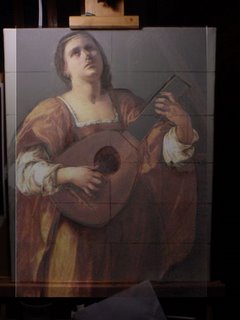Bobby Chiu reccomends copying artists you admire several times. First copy their drawing, then copy their color, then copy their styles to add to your arsenal of skills. I am taking his advice.
I have been out of the drawing habit for far too long. When I was going to the studio my drawing skills improved by leaps and bounds. Drawing is not like riding a bike. If you don't use it, you do lose it. Knowing this, I have been half intimidated to draw anything at all. After listening to Bobby's kind words, I found a brave cell in my brain and decided to go for it. The worse that could happen is that I could waste some paper or some paint and canvas right?
Charcoal is very forgiving. Correcting mistakes is as easy as wiping down an area and redrawing it. I am a member of Wetcanvas. They have an article on underpainting called "Underpainting - A primer for the new painter" that I reccomend to anyone that wishes to copy an old master painting. Before you can open a tube of paint, you must get an accurate drawing to work with.
In order to train my mind, I am doing this in a less than conventional method. I have drawn in a rough grid, but I don't want to be dependant upon it. I am very familiar with the sight size method, but don't have the resources to blow this painting up in a 16x20 size. So I am adapting and adjusting. The grid serves more to line things up each time I take a new picture into photoshop than as a guide in my drawing.
I am using my small printed copy to get basic shape and lines put on my canvas and as I go, I am taking pictures and placing the original in a 50% fill layer over my drawing to compare. Once I make a comparison, I go back to my drawing on my canvas and make adjustments.


The Lute Player
Charcoal on Canvas
16x20


As you can see, there are errors everywhere. This is the slow way to do this, but it is a very important lesson for my visual training. Each time I step away from the computer, I have to memorize angles and curves and placements. Each correction is making me painfully aware of its relative position within this painting. The goal of doing this drawing in this method is to get back to my ability to truly see and make better estimates. As I go, I am noticing myself recognize mistakes before I consult my overlay. That is the most important reason for doing this using this method. In all honesty, I am so bad that I should be doing sight size drawings. While I do appreciate the value of doing such work, I simply cannot drill through another bargue drawing.
I am currently reading "The Practice and Science of Drawing" by Harold Speed with the classical group on Wetcanvas. You can join us HERE. This book is amazing. Speed discusses the emotional/mental reasons to draw and study classical art. Between Speed, Bobby Chiu, the wonderful people on Wetcanvas and my own willpower, I think I can tackle this to at least a presentable result. ... And if all else fails, Bobby says to do it again.. so you can't do it again if you didn't do it at least once.


0 Comments